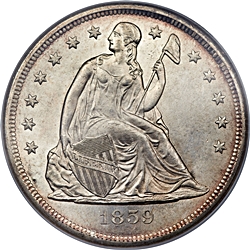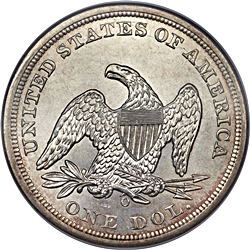 |
1859-O
 

|
 |
General Comments
1859-O is one of the two most-available dates in the Liberty Seated dollar series (the other is 1860-O), not because their
mintages are the highest, but because of the release of coins from the treasury hoard in the 1950ís and early 1960ís.
Dave Bowers cites many estimates of the coins released (reference 4). We can summarize the situation by saying that at
least 2000 1859-O coins were released, and that the ratio of 1859-O coins to those of 1860-O is about 1:2. As a result of
the treasury releases mint state examples are extremely common. However, since most of the coins released had been kept
in bags for nearly 100 years, the average mint state grade is low. Most examples are heavily bag-marked.
|
| |||||||||||||||||||
1859-O examples are usually well struck. In fact, if strike is one of your strong interests, this is probably one of the best dates in the series to look for. A strong strike seems to be the rule rather than the exception. Iíve seen a few examples that display softness on the right-side stars, including a MS65 coin graded by NGC thatís one of the five finest known, but itís almost tougher to find a coin that displays a weak strike than to find one thatís well-defined. Similarly, Iíve seen a few that show some flatness on the eagleís left talon, but only a few. This is one of the few dates that almost never shows weakness on the upper left edge of the eagleís wing. They may be common, but at least you can find them well struck!
1859-O surfaces are usually frosty. They can be found prooflike, but with a large mintage and only four die pairs identified so far, the runs were long enough that most of the coins exhibit frosty surfaces. Prooflike examples are very difficult to locate.
1859-O Die Marriages
Two obverse dies were paired with three reverses to strike a total of four die marriages. None seem to be excessively rare, although locating an example of OC-5 can be difficult. Note that OC-4 is unassigned, as is Reverse C. I originally believed that a third Obverse die and fourth reverse existed in a die marriage OC-4. However, after completing my original research I determined that Obverse 3 was a late state of Obverse 1. Similarly, Reverse C was an early state of Reverse A. To maintain my practice of not changing die marriage terminology after the initial activation of my web site (www.seateddollarvarieties.com) Iíve eliminated die marriage OC-4 and Reverse C, while maintaining all other previously defined die identifiers and die marriage nomenclature.
Click the links below to view the details of the known 1859-O die marriages.
Die Marriage |
Rarity |
Obverse Die |
Reverse Die |
Estimated Survivors |
| OC-1 | R1 | 1 | A | 4150 |
| OC-2 | R1 | 1 | B | 1800 |
| OC-3 | R2 | 2 | B | 900 |
| OC-5 | R4 | 1 | D | 150 |
Note that Breen (reference 20) identified two different varieties. He listed Breen 5459 as ďnormal date, heavy mintmarkĒ. Breen 5460 was listed as ďHeavy date, thin mintmarkĒ. I donít consider the differences as significant enough to note. I believe that Breen 5459 represents my die marriages OC-1 and OC-5. Breen 5460 represents my die marriages OC-2 and OC-3.
As can be seen from the survival estimates most of the coins released by the Treasury in the early 1960ís were predomantly die marriages OC-1 and OC-2.
1859-O Emission Sequence
Each 1859-O die marriage shared one or both dies with at least one other marriage.
This allowed conclusive determination of the emission sequence.
>
Die Pair |
||
| 1 | OC-5 | Largest unfinished area under the chin and earliest state of Obverse 1 indicate that this of the earliest use of Obverse 1. Obverse 1 clashed during this usage. |
| 2 | OC-1 | Obverse 1 clashing advanced from state b to state d during this usage. |
| 3 | OC-2 | Obverse 1 was polished before this usage. This die marriage has been seen only with obverse state d, but with both reverse states a and b. |
| 5 | OC-3 | This die marriage has been seen only with reverse die state b. |
1859-O Quick Finder Chart
1859-O examples can be difficult to attribute, even though very few dies are involved. Reverses A and D are very similar
although the mintmark rotation is slightly different. Obverse 1 was used to strike most of the coins issued during the
year, making it one of the most-used dies in the entire series. The differences between the diagnostics for early and
late die states can be significant, making some examples appear to have a different obverse.
Die Marriage |
Obv Die |
Rev Die |
Right |
Keys |
| OC-1 | 1 | A | L QTR | Obverse: No notable markers other than date position. RB of 1 is L QTR. Reverse: Mintmark high, very close to stem and feather tip, slightly left of centered, slight CW rotation. Die cracked in later states. |
| OC-2 | 1 | B | L QTR | Obverse: No notable markers other than date position. RB of 1 is L QTR. Reverse: Mintmark well-separated from stem and feather tip. A tiny lump at the top of the first shield recess. Other markers at the top of recesses #2 and #3. |
| OC-3 | 2 | B | R QTR | Obverse: A tiny lump on the hemline right of the shield tip. RB of 1 is R QTR. Reverse: Mintmark well-separated from stem and feather tip. A tiny lump at the top of the first shield recess. Other markers at the top of recesses #2 and #3. |
| OC-5 | 1 | D | L QTR | Obverse: No notable markers other than date position. RB of 1 is L QTR. Reverse: Mintmark high, very close to stem and feather tip, slightly left of centered, no rotation. Lumps created by die rust around ONE, leaves, and lower left wing. |
| Photo credits:
Obverse and reverse full photos: 1859-O NGC MS65, tied for finest known, ex. Gene Gardner, from the Heritage archives. |
